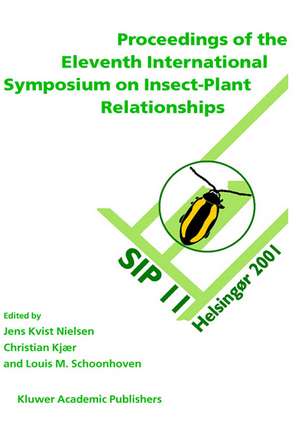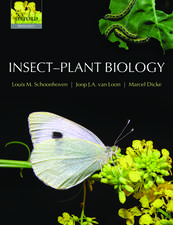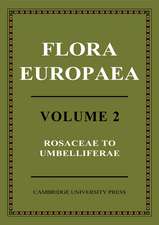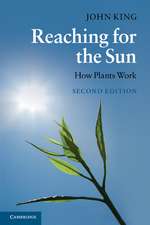Proceedings of the 11th International Symposium on Insect-Plant Relationships: Series Entomologica, cartea 57
Editat de Jens Kvist Nielsen, Christian Kjær, Louis M. Schoonhovenen Limba Engleză Hardback – 31 ian 2003
| Toate formatele și edițiile | Preț | Express |
|---|---|---|
| Paperback (1) | 1218.83 lei 43-57 zile | |
| SPRINGER NETHERLANDS – 27 ian 2011 | 1218.83 lei 43-57 zile | |
| Hardback (1) | 1230.66 lei 43-57 zile | |
| SPRINGER NETHERLANDS – 31 ian 2003 | 1230.66 lei 43-57 zile |
Din seria Series Entomologica
-
 Preț: 393.90 lei
Preț: 393.90 lei -
 Preț: 385.25 lei
Preț: 385.25 lei -
 Preț: 414.42 lei
Preț: 414.42 lei -
 Preț: 393.90 lei
Preț: 393.90 lei - 18%
 Preț: 830.70 lei
Preț: 830.70 lei - 18%
 Preț: 1220.75 lei
Preț: 1220.75 lei - 18%
 Preț: 1841.32 lei
Preț: 1841.32 lei - 18%
 Preț: 1218.04 lei
Preț: 1218.04 lei - 18%
 Preț: 1223.25 lei
Preț: 1223.25 lei -
 Preț: 385.62 lei
Preț: 385.62 lei - 24%
 Preț: 811.86 lei
Preț: 811.86 lei -
 Preț: 351.51 lei
Preț: 351.51 lei - 18%
 Preț: 810.99 lei
Preț: 810.99 lei -
 Preț: 403.53 lei
Preț: 403.53 lei - 18%
 Preț: 936.93 lei
Preț: 936.93 lei - 15%
 Preț: 642.83 lei
Preț: 642.83 lei -
 Preț: 393.59 lei
Preț: 393.59 lei - 18%
 Preț: 1664.26 lei
Preț: 1664.26 lei - 18%
 Preț: 1217.27 lei
Preț: 1217.27 lei - 18%
 Preț: 1386.30 lei
Preț: 1386.30 lei - 18%
 Preț: 1831.27 lei
Preț: 1831.27 lei - 18%
 Preț: 951.14 lei
Preț: 951.14 lei - 18%
 Preț: 2107.18 lei
Preț: 2107.18 lei - 18%
 Preț: 1219.77 lei
Preț: 1219.77 lei - 18%
 Preț: 1832.22 lei
Preț: 1832.22 lei - 18%
 Preț: 1229.91 lei
Preț: 1229.91 lei - 18%
 Preț: 1594.64 lei
Preț: 1594.64 lei - 18%
 Preț: 1833.16 lei
Preț: 1833.16 lei - 18%
 Preț: 1392.95 lei
Preț: 1392.95 lei - 18%
 Preț: 1237.93 lei
Preț: 1237.93 lei - 18%
 Preț: 1219.31 lei
Preț: 1219.31 lei - 24%
 Preț: 1073.70 lei
Preț: 1073.70 lei -
 Preț: 389.70 lei
Preț: 389.70 lei - 18%
 Preț: 1246.15 lei
Preț: 1246.15 lei - 18%
 Preț: 1226.70 lei
Preț: 1226.70 lei - 18%
 Preț: 1225.31 lei
Preț: 1225.31 lei - 18%
 Preț: 1232.89 lei
Preț: 1232.89 lei - 18%
 Preț: 1832.22 lei
Preț: 1832.22 lei - 18%
 Preț: 1232.71 lei
Preț: 1232.71 lei - 24%
 Preț: 1604.87 lei
Preț: 1604.87 lei
Preț: 1230.66 lei
Preț vechi: 1500.81 lei
-18% Nou
Puncte Express: 1846
Preț estimativ în valută:
235.49€ • 246.49$ • 195.100£
235.49€ • 246.49$ • 195.100£
Carte tipărită la comandă
Livrare economică 31 martie-14 aprilie
Preluare comenzi: 021 569.72.76
Specificații
ISBN-13: 9781402008900
ISBN-10: 1402008902
Pagini: 272
Ilustrații: VIII, 262 p.
Dimensiuni: 178 x 254 x 20 mm
Greutate: 0.82 kg
Ediția:2002
Editura: SPRINGER NETHERLANDS
Colecția Springer
Seria Series Entomologica
Locul publicării:Dordrecht, Netherlands
ISBN-10: 1402008902
Pagini: 272
Ilustrații: VIII, 262 p.
Dimensiuni: 178 x 254 x 20 mm
Greutate: 0.82 kg
Ediția:2002
Editura: SPRINGER NETHERLANDS
Colecția Springer
Seria Series Entomologica
Locul publicării:Dordrecht, Netherlands
Public țintă
ResearchCuprins
Encoding of plant odour information in insects: peripheral and central mechanisms.- How do herbivorous insects cope with noxious secondary plant compounds in their diet?.- Flavonoids from cabbage are feeding stimulants for diamondback moth larvae additional to glucosinolates: Chemoreception and behaviour.- The chemical world of crucivores: lures, treats and traps.- The role of pollen odour in the attraction of pollen beetles to oilseed rape flowers.- Insect feeding deterrent activity of lignans and related phenylpropanoids with a methylenedioxyphenyl (piperonyl) structure moiety.- Host specificity and host recognition in a chemically-defended herbivore, the tenthredinid sawfly Rhadinoceraea nodicornis.- Effects of age, sex, and dietary history on response to cucurbitacin in Acalymma vittatum.- Incidence of apple fruit and leaf surface metabolites on Cydia pomonella oviposition.- The role of sinigrin in host plant recognition by aphids during initial plant penetration.- Within species variation in host plant quality and movement behavior of Lygus rugulipennis nymphs.- Xylem ingestion by winged aphids.- The effect of different plant nutrient regimes on the aphid Macrosiphum euphorbiae growing on petunia.- Performance of pine looper Bupalus piniarius larvae under population build-up conditions.- Interactive effects of leaf maturation and phenolics on consumption and growth of a geometrid moth.- Aphid response to elevated ozone and CO2.- The effect of ozone fumigation and different Brassica rapa lines on the feeding behaviour of Pieris brassicae larvae.- Host plant derived feeding deterrence towards ants in the turnip sawfly Athalia rosae.- Qualification of grassland habitats based on their Orthoptera assemblages in the Köszeg Mountains (W-Hungary).- Insect-plantinteractions on a planet of weeds.- Induction of plant responses to oviposition and feeding by herbivorous arthropods: a comparison.- Larval feeding experience influences adult predator acceptance of chemically defended prey.- Do fecal shields provide physical protection to larvae of the tortoise beetles Plagiometriona flavescens and Stolas chalybea against natural enemies?.- Host plant use of Phyllotreta nemorum: do coadapted gene complexes play a role?.- Evolution of insect-plant relationships: chemical constraints, coadaptation, and concordance of insect/plant traits.- Concluding remarks.- Index of authors.- General index.- Listing of oral and poster presentations from SIP11.- List of registered participants.









